powered
by
FreeFind
Great Eastern Railway
Fleet List
Claud Hamilton (GER: 1875-1897 - 922 grt)
Claud Hamilton was built in 1875 for the Harwich-Holland
route. She was named after the GER chairman. Built by John Elder, Claud Hamilton
was nearly 1000grt, setting new standards on the service. Her 22
years in service did much to ensure the popularity of the
Harwich routes. She was the last paddle steamer in the GER
fleet, but in 1897 she was sold to the City of London who
converted her to carry cattle from Gravesend to Deptford, which
she did for a further 17 years.
Claud Hamilton in use by London City
Council (LCC) as a cattle boat
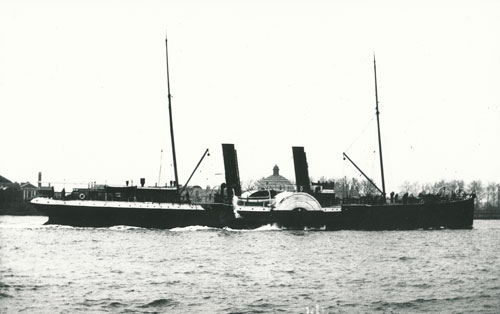
Ipswich
(GER: 1883-1906 - 1067 grt)
Norwich
(GER: 1883-1905 - 1,062 grt)
The
first screw steamers were the Ipswich
and Norwich which were built for the Harwich-Antwerp service.
They were delivered in 1883 from Earle's
Shipbuilding of Hull. In the same year Parkeston Quay opened. These were
iron steamers powered by twin 2-cylinder compound engines giving a
combined 2000ihp resulting in a speed of 14kt.They had berths for
84 first class passengers and 42 second class. In 1906
Ipswich was sold to Shah SN Co, Bombay,
but was scrapped in 1909. In 1905 Norwich was sold to the Channel Drydock & Shipbuilding
Co, Harwich. She was later based in the Cape Verde Islands before passing to
owners in Montevideo and then New York. She was lost in 1921 when owned
by the Mexican Fruit and Steamship Company.
Norwich by the Town Quay with the
survived Halfpenny Pier kiosks on the far right.
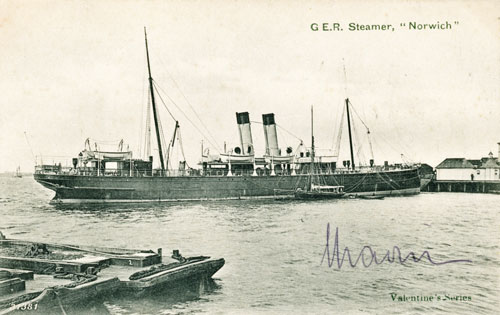
Cambridge (GER: 1886-1912 - 1196
grt)
The success of
Ipswich and
Norwich led to the order for
a slightly larger vessel from Earle's. Cambridge was built in 1886 for Harwich-Rotterdam/Antwerp/Hook
services. She was 20ft longer and slightly more powerful at 2200ihp giving a
speed of 14.5kt. 134 first class and 56 second class berths were
provided, whilst total passenger capacity was 730. A sister
Colchester was delivered
in 1889. In 1912 she was sold to Anglo-Ottoman SS Co.
Postcard of Cambridge
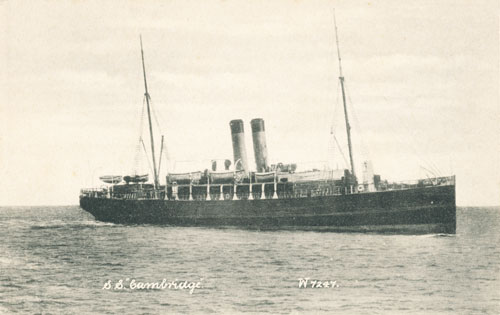
Cambridge in drydock at Antwerp
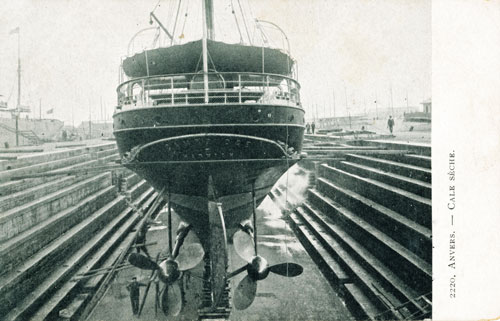
Colchester (GER: 1889-1916 - 1160
grt)
A sister to
Cambridge,
the Colchester was built in for the 1889 Harwich-Rotterdam
service. She was re-engined with a pair of four-cylinder triple expansion
engines in 1900, which improved fuel economy. In 1916
Colchester was captured by German warships.
In 1918 she was grounded and abandoned at Kiel, and was scrapped
in 1919.
Postcard of Colchester
I have not been able to identify the
single-funnelled steamer with grey hull on the left
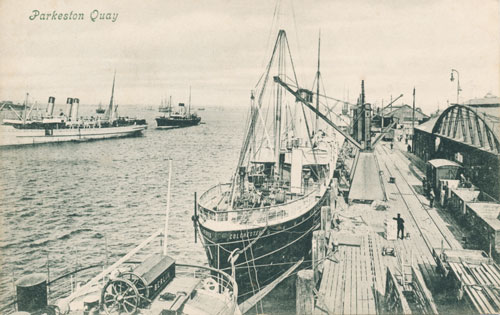
Postcard of Colchester
I have not been able to identify the
single-funnelled steamer with grey hull on the left
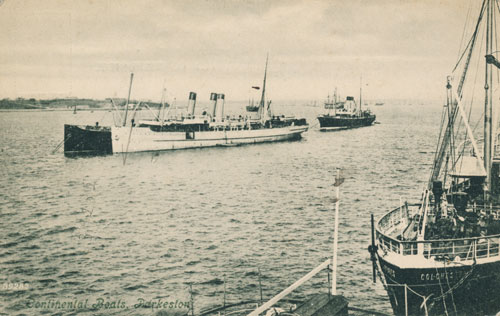
Postcard of Colchester
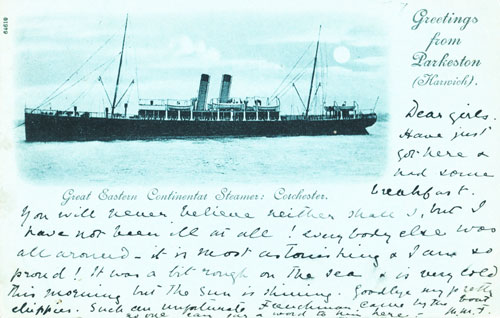
Chelmsford (GER: 1893-1910 - 1635
grt)
Chelmsford was built in 1893 for the Harwich-Hook
route. In 1910 she was sold to the Great Western Railway renamed
Bretonne.
Amsterdam (GER:1894-1922 - 1745
grt)
Amsterdam (LNER:1923-1928 - 1745
grt)
Amsterdam was built in 1894 for the Harwich-Hook
route. She moved to the Harwich-Antwerp route in 1910, and was
scrapped in 1928.
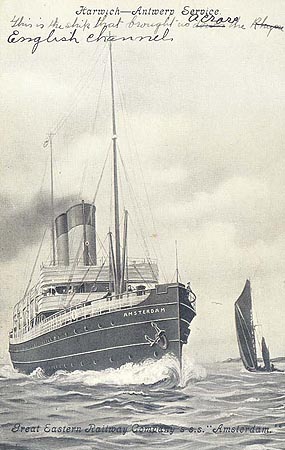
Berlin
(1894-1907 - 1745 grt)
Berlin was built in 1894 for the Harwich-Hook
route. In 1907 she was wrecked at entrance to the New Waterway
with the loss of 128 lives.
Wreck
of the Berlin.
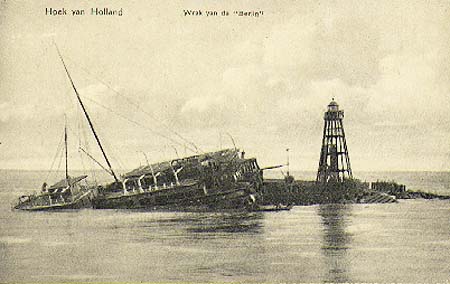 Wreck
of the Berlin.
Wreck
of the Berlin.
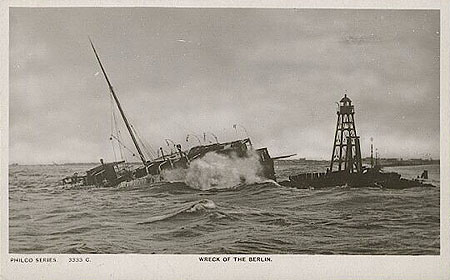
Vienna
(GER: 1894-1920 -1753 grt)
Roulers (GER: 1920-1922)
Roulers (LNER: 1923-1930)
Vienna 1894 Harwich - Hook, 1910 Harwich
- Antwerp, 1920 renamed Roulers, Harwich - Zeebrugge,
1930 scrapped.
Official GER card of Vienna
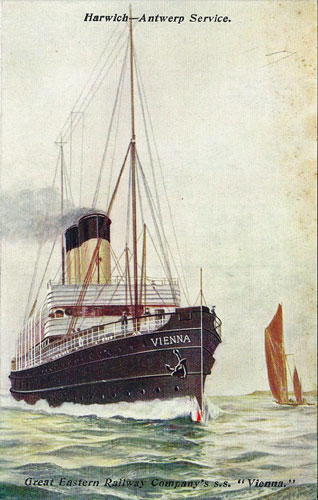
Dresden
(1897-1915 - 1,805 grt)
Louvain (1915-1918)
Dresden was built in 1897 for the Harwich-Antwerp
route. In 1915 she was taken over by Admiralty and renamed Louvain,
but in 1918 was sunk by U-Boat in Aegean Sea.
Official GER postcard
of Dresden
Scan:
Leo Palmer
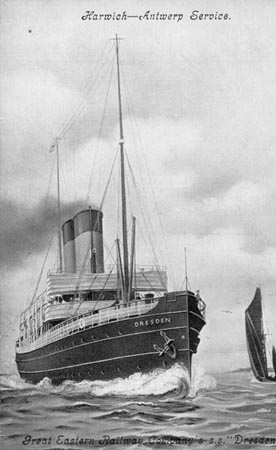
Photo postcard of Dresden
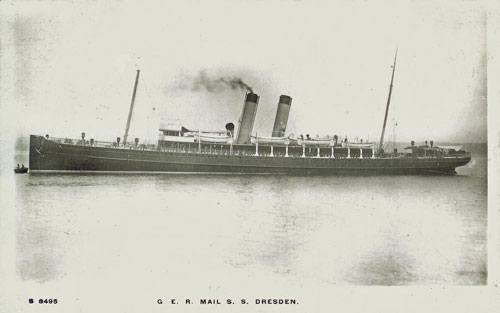
Brussels (1902-1920 - 1380 grt)
Brussels was built in 1902 for the Harwich-Antwerp
service. In WW1, she transferred to the Tilbury-Hook route, and
was captured by German warships in 1916. Her master, Captain
Fryatt, was executed by German firing squad for attempting to
ram a U-Boat which had attacked his ship. In 1920 she was sold
to the Dublin & Lancashire SS Co, and later served with the
British
& Irish SP Co
as
Lady
Brussels.
Postcard
issued in the war to after the execution of Captain Fryatt.
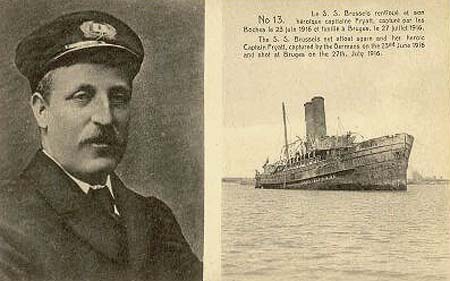
Kilkenny (1917-1919 - 1419 grt)
Frinton (1919-19xx)
Kilkenny was built in 1903 for the City of Dublin SP Co. In 1917 she was purchased by
the GER for the Harwich-Rotterdam service. In 1919 Kilkenny
was renamed Frinton.
Copenhagen (GER: 1907-1917 - 2570 grt)
Copenhagen was built in
1907 for the Harwich-Hook route. In 1917 she was torpedoed and
sunk in the North Sea.
Munich
(GER: 1908-1914 - 2570 grt)
St Denis (GER: 1918-1922)
St Denis (LNER: 1923-1940)
Munich was built in 1908 for the Harwich-Hook
service. In WW1 she was used as the hospital ship St Denis,
retaining the name afterwards. In 1940 she was caught in Amsterdam,
and was scuttled. She was raised and used by Germans, and was
scrapped in 1950.
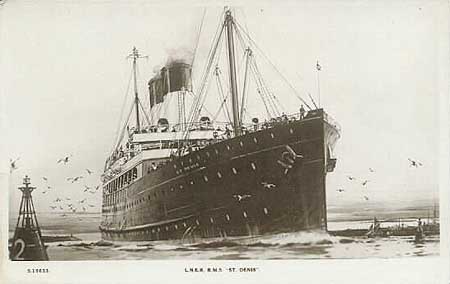
St. Petersburg (GER: 1910-1916 - 2570 grt)
Archangel (GER: 1916-1922)
Archangel (LNER: 1923-1941)
St. Petersburg was built in 1910 for the Harwich-Hook
service. In 1916 she was renamed renamed Archangel. Archangel
was bombed and sunk off East coast of Scotland in 1941.
St George (GER: 1919-1922 - 2456 grt)
St George (LNER: 1923-1929)
St George was built in 1906 for the Great
Western railway's Fishguard-Rosslare service. She was sold to
the Canadian Pacific Railway, and purchased from them by the
GER in 1919, retaining her original name St George throughout.
She was scrapped in 1929.
Antwerp
(GER: 1920-19221 - 2957 grt)
Antwerp (LNER: 1923-1951)
Antwerp was built in 1920 for the Harwich-Antwerp
service. In 1945 she became the Harwich-Hook army leave ship.
Antwerp was scrapped in 1951.
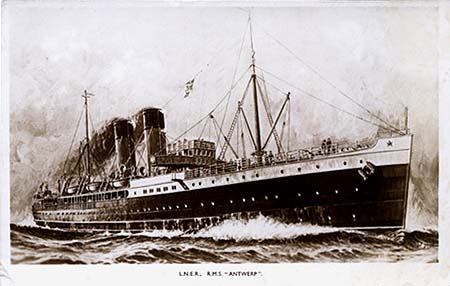
Bruges
(GER: 1920-1922 - 2949 grt)
Bruges (LNER: 1923-1940)
Bruges was built in 1920 for the Harwich-Antwerp
service In 1940 she was bombed and sunk near Havre while trooping.
Malines (1921-1922 - 2969grt)
Malines
(1923-1948)
Malines was built in 1921 for the Harwich-Antwerp
service. She was laid up in 1945, and scrapped in 1948.
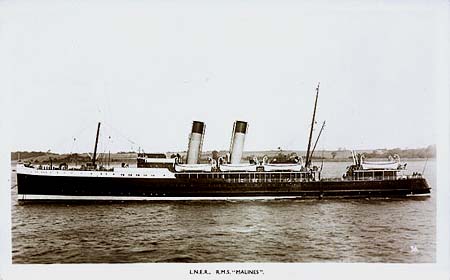
Train Ferry No. 1 - Essex
Ferry (1) (1924-1957
- 2683 grt)
Train
Ferry No. 2 (1924-1940
- 2678 grt)
Train
Ferry No. 3 (1924-1945
- 2672 grt)
These three train ferries
were built as part of the WW1 war effort in 1917 to operate from
Richborough Military Port (in Kent) to Dunkirk. Despite attempts
to interest the local railway companies in continuing the service
from Richborough, the ferries were laid up. In 1922. the Great
Eastern Railway considered using these ferries from Harwich.
The Belgians were the most interested in providing a continental
terminal, and two companies were formed in 1923, Great Eastern
Ferries Ltd and Le Société Belgo-Anglaise Des Ferry-Boats
SA, although the Great Eastern railway itself had become part
of the London & North Eastern Railway (LNER) by this time.
In 1924 a new Harwich-Zeebrugge route was started, using original
original gantries and linkspans from Richborough and Southampton.
The three wartime ferries were refitted for service, retaining
their names Train Ferry No.1, Train Ferry No.2
and Train Ferry No.3, henceforth referred to as TF1,
TF2 and TF3. The service was operated by the LNER
for freight only. Great Eastern Ferries Ltd went into liquidation
in the depression in 1932, and its assets were purchased by the
LNER.
During WW2, the three
ships were requisitioned by the Royal Navy , TF2 was lost
off Saint-Valéry en Caux June 13th 1940. In 1940 TF1
and TF3 were renamed HMS Princess Iris and HMS
Daffodil, after the ex-Mersey ferries used in the famous
WW1 Zeebrugge raid. In 1941 HMS Princess Iris and HMS
Daffodil were converted into Landing Craft Carriers. Both
ships were modified with their twin funnels trunked into one,
slightly improving their ungainly appearance. HMS Daffodil
(ex-TF3) was lost off Dieppe on March 18th 1945, leaving
only HMS Princess Iris (ex-TF1) to survive the
war. She returned to civilian use in 1946, and was renamed Essex
Ferry (1), running three return trips a week to Zeebrugge.
She was joined by new ferries
Norfolk Ferry and
Suffolk Ferry in 1951.
Essex Ferry (2) joined them in 1957, and Essex
Ferry (1) was briefly renamed Essex Ferry II before
being broken up in Grays.
There are a lot of conflicting
details of these ferries in published works. Some sources, including
H.T.Lenton, list TF2, not TF3, as becoming HMS
Daffodil. Other sources suggest that HMS Princess Iris
was briefly named HMS Iris, or that HMS Daffodil was
later renamed HMS Princess Daffodil.
Train
Ferry No.2 at
Zeebrugge.
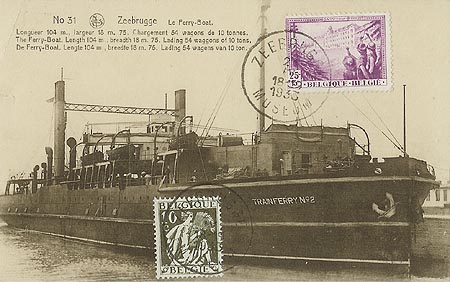
Train
Ferry No.3.
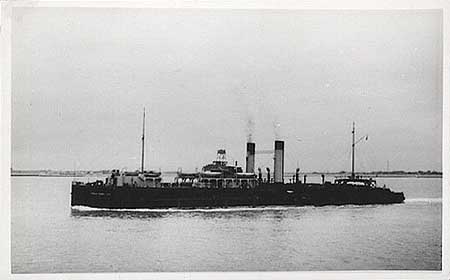
Train
Ferry No.3 at
Harwich.
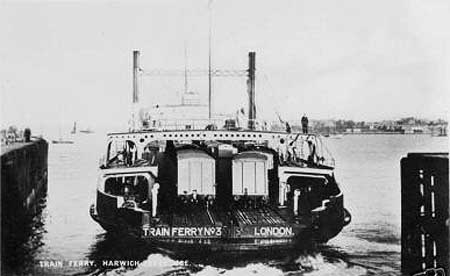
Train
Ferry No.3 at
Zeebrugge.
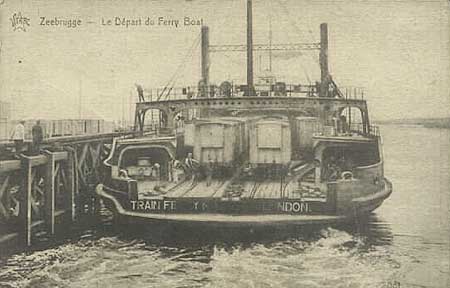
Ferry
Postcards
-
Cruise
Ship Postcards
-
Ocean
Liner Postcards
Top
of Page
-
Simplon
Postcards - Recent Updates -
Simplon Postcards
- Home Page